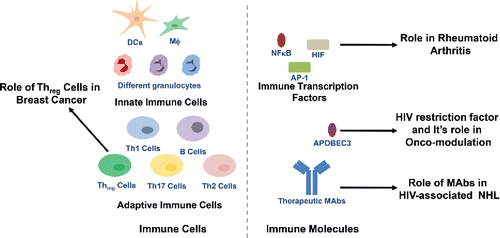Hierarchical organizations and coordinated interaction between immune cells and molecules enables the host to combat pathogenic insults and protect against physiological disequilibrium due to dysregulated cellular processes, leading to uncontrolled cell growth or autoimmune disease. This issue of International Reviews of Immunology describes the interaction between cellular signaling pathways in the development of autoimmune diseases, and their importance to antitumor immunotherapy. This issue also discusses the prognostic potential of immune cells in cancer ().
Various transcription factors such as Nuclear factor (NF)-κB, Activator protein (AP)-1, the family of Hypoxia-inducible factor (HIF), and others play a pivotal role in an array of immunological processes. These immunological processes include development, maturation and proliferation of immune cells, and induction of inflammation. The first review article of this issue
Figure 1. Immune cells and molecules in Rheumatoid Arthritis, Cancer and in Cancer Immunotherapy: Dendritic cells, DCs; Macrophages, Mφ; T helper, Th; T helper regulatory, Threg; Nuclear factor-κB, NF-κB; Activator protein-1, AP-1; Hypoxia-inducible factor, HIF; and Apolipoprotein B editing complex 3, APOBEC3.

by Rossignol et al. discusses how various transcription factors are involved in the pathogenesis of rheumatoid arthritis. The review also discusses the potential application of these transcription factors or their regulators in therapy. However, careful consideration must be applied as modulation of some of these targets transcription factors (NF-κB, AP-1 etc) may enhance susceptibility to infectious disease and cancer. Therefore, careful investigation is required before considering and advancing such modulators as therapeutic agents for rheumatoid arthritis ().
Amongst all cancers, breast cancer is the leading tumor type that causes death in women worldwide. Breast cancer overexpressing Human epidermal growth factor receptor (HER)2 is a type of breast cancer that grows and spreads faster. This cancer type is difficult to control as it develops resistance to cancer therapy. The second review article in this issue, written by Banin-Hirata et al., focuses on cancer and adaptive immune cell interaction. In their review, the authors discuss the infiltration of regulatory T (Treg) lymphocytes in breast cancer tissues, which depends on breast cancer-type. The authors also highlight that infiltration of Treg cells in cancerous tissues has prognostic potential in terms of progression of cancer, which may be useful in diagnosis of breast cancer and adopting the course of therapy in patients. ().
Apolipoprotein B editing complex (APOBEC3) is a DNA-editing enzyme with cytidine deaminases activity. It is a crucial restriction factor against different families of viruses, particularly retroviruses such as HIV-1. The third review article in this issue by Borzooee et al, discusses the role of APOBEC3 in oncogenic and anticancer activity compared with antiviral activity. The authors also shed light on similarities between viruses and cancer, such as rapid evolution and adaptation, and the authors speculate that antiviral immune strategies can be extrapolated to control cancer as APOBEC3 may promote generation of neo-antigens in cancerous cells/tissues to the host immunity and further it may promote clearance of cancer by host immunity ().
HIV infection weakens host immunity by mainly targeting and depleting CD4 T lymphocytes. HIV infection leads to opportunistic microbial infection and development of different types of cancer/tumor. The last review article of this issue by Rezahosseini et al. describes non-Hodgkin Lymphoma associated with HIV infection, and highlights an increased incidence of this condition (60-200 fold) during high viral load and low CD4 count in older male patitents.. The authors discuss the application of monoclonal antibodies in the treatment of non-Hodgkin Lymphoma during HIV infection. ().
References
- Scott Le Rossignol, Natkunam Ketheesan, Nagaraja Haleagrahara. Redox-sensitive transcription factors play a significant role in the development of rheumatoid arthritis. Int Rev Immunol. 2018;37(3):129–143.
- Bruna K. Banin-Hirata, Carlos E. C. de Oliveira, Roberta Losi-Guembarovski. The prognostic value of regulatory T cells infiltration in HER2-enriched breast cancer microenvironment. Int Rev Immunol. 2018;37(3):144–150.
- Faezeh Borzooee, Mahdi Asgharpour, Emma Quinlan. Viral subversion of APOBEC3s: lessons for anti-tumor immunity and tumor immunotherapy. Int Rev Immunol. 2018;37(3):151–164.
- Omid Rezahosseini, Sara Hanaei, Mehdi Hamadani. The promising role of monoclonal antibodies for immunotherapy of the HIV associated cancer, non-Hodgkin lymphoma. Int Rev Immunol. 2018;37(3):165–173.
